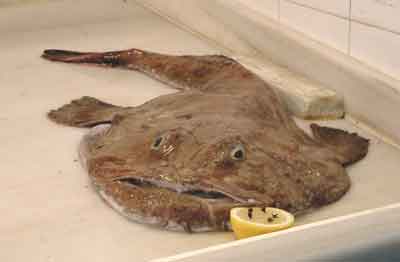Monkfish (US: Angler fish) is a fish with tail meat which has a sweet flavour and succulent firm flesh, almost like lobster meat, entirely compensating for is appearance as it has the ugliest looks imaginable. It can be recognised by its hideous head and fan-shaped fins which, like the operculum, are spiny. The fish is often displayed without the head. With the skin on the tail is muddy coloured but, without it, a translucent pink. The flavour may well be assisted by its own diet which is high in shellfish. The tail is covered with a tough transparent membrane. It is best to remove this before cooking as heat causes the membrane to shrink around the meat of the fish, curling it up. It can be quite a fiddle to remove but is worth the effort.
The monkfish is found in the Mediterranean and Atlantic and in coastal waters of north western Europe. It can be eaten fried or in soups and stews. It keeps its form well in cooking. Larger fish often have better flavour. The best monkfish are Lophius piscatorius and the similar Lophius budegassa, the favourite of the Spanish. American monkfish or goosefish (Lophius americanus) is considered inferior, while New Zealand monkfish (Kathetostoma giganteum) is related to the stargazer and is only fit for soup.
It is said that the skin, when peeled away from the tail, resembles a monk's cowl, giving the fish its name. However, there is another fish, Squatina squatina, the angel or fiddle fish, which is sometimes called monkfish and really does look like a monk in a cowl. The monkfish also known as the anglerfish as it bears on its head a 'rod' and 'lure' which attract its prey.
